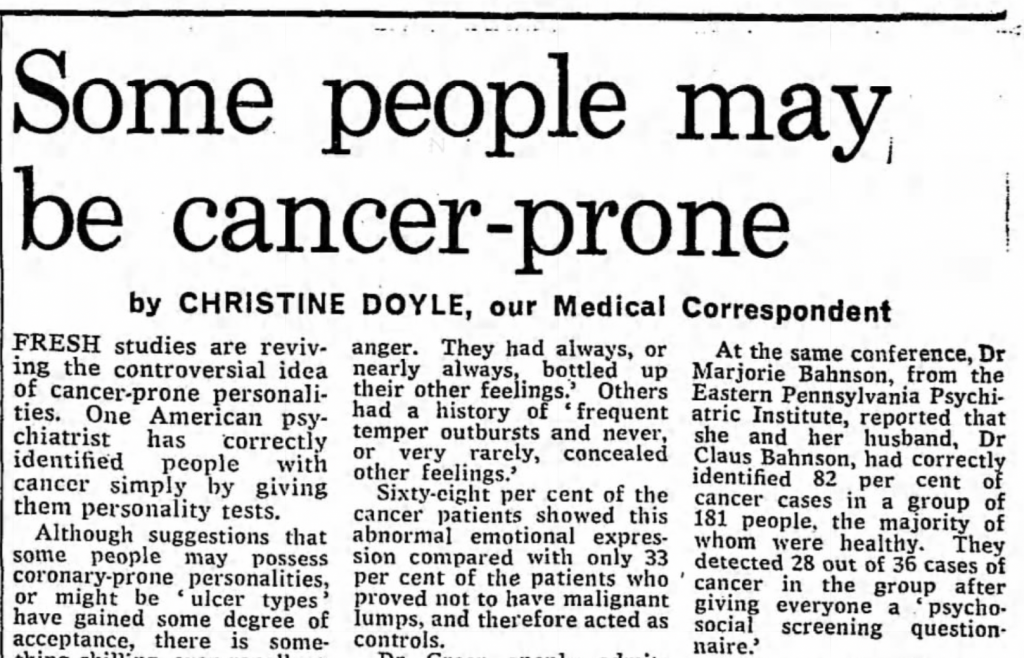Since ancient times, the onset of cancer has been linked to depression and melancholia. Hopelessness, despair, and sorrow were regularly mentioned as a trigger of cancer until modern research refuted such a connection.
In the second half of the 20th century, the idea of a cancer-prone personality became widespread in both the scientific and popular press. People who repressed their anger and emotions were said to be at higher risk of developing cancer. Behavioral therapy was proposed as a treatment and prophylaxis. Our investigation shows that some of the researchers who introduced these ideas were financially supported by the tobacco industry to turn attention away from causal links between smoking and cancer.
Another psychosomatic myth states that having a positive attitude or a “fighting spirit” leads to a better prognosis. The notion that patients could cure themselves of cancer if they had the right attitude or tried hard enough to overcome it, became popular in the 1970s and 1980s. These ideas were not supported by scientific evidence and led to stigma, guilt, and frustration.
As we will discover, the history of cancer has surprisingly many of these episodes. We will therefore divide it into three parts. Today, in part II, we take a closer look at the cancer-prone personality.

Emotional repression
In Part I, we saw how psychoanalytically oriented researchers speculated about an ‘Amazon complex’ and the excremental meaning of cancer. These papers were so absurd that, luckily, they had little influence. That cannot be said of the recurrent myth we are about to explore now. This is the second key idea that keeps returning in the psychosomatic literature of cancer: the view that people who repress their anger and emotions are more likely to develop cancer.
This idea was occasionally expressed in the old papers we discussed in part I, but it fully came to prominence with the work of the Scottish physician David Kissen. It could be said that Kissen performed the first ‘modern’ psychosomatic study of cancer because he used a control group, statistical comparisons, and a validated questionnaire rather than some unreliable projective test. He teamed up with the influential psychologist Hans Eysenck who had just developed a questionnaire to measure two personality dimensions: extraversion and neuroticism. Lung cancer patients scored low for neuroticism and Kissen interpreted this as proof that they had “a significantly diminished outlet for emotional discharge compared with non-cancer patients”. In a paper titled ‘The significance of personality in lung cancer in men’ Kissen wrote that patients “tend to bottle up or conceal their emotional difficulties” and that “this unconscious inability to deal adequately with emotional conflict, has a close and significant association with lung cancer.”
Other researchers joined in to repeat the same message. It was claimed that cancer patients are emotionally frustrated, that they have an inability to deal adequately with emotional conflict or to appropriately discharge their anger. They were said to be unable to vent their feelings and frustrations. As one paper summarized the literature: “The most important psychosocial factor for carcinogenesis seems to be the chronic blockade of expression of feelings and desires.” In a 1976 article in the National Observer titled “Cancer and personality, can they be connected?” one expert explained the psychosomatic theory as follows:
“There is a lot of energy involved in these tensions. When you don’t do anything, where does that energy go? It has been found that it can go to disrupt bodily functions associated with, say, metabolism and circulation.”
In other words, failure to express your feelings and emotions can build up over time and result in the formation of a tumor mass. This idea reached its way into mainstream culture. A good example is the film ‘Manhattan’ where the character played by Woody Allen says: “I don’t get angry, okay?” … I mean, I have a tendency to internalize. That’s one of the problems I have. I – I grow a tumor instead.”
Type C
Eventually, researchers started to use these myths to form the concept of a cancer-prone personality. Clinical health psychologist Lydia Temoshok, who studied patients with melanoma, called it ‘Type C’ to differentiate it from ‘Type A’ that was believed to predispose people to heart disease. While type A people were said to be assertive, competitive, and self-centered, Type C people were just the opposite. They were cooperative, patient, and self-sacrificing; more involved in meeting other people’s needs rather than their own. Cancer patients did not experience or express negative emotions such as anger, anxiety or fear appropriately. As Temoshok writes: “they kept their feelings in check, maintained a pleasant demeanor, never complained, and focused selflessly on the needs of those close to them.” They coped with their disease by keeping their feelings under wraps. Like many of her predecessors, Temoshok wrote a book in which she offered advice on how cancer patients could change their Type C behavioral patterns by getting in touch with their inner guide and learning to express their emotions.
Other researchers joined in to support the idea of a cancer-prone personality. Dr. Maria Blohmke, the first female president of the Deutsche Sozialmedizinische Gesellschaft claimed that “cancer patients tend to deny and displace emotions and conflicts to a higher degree than other persons.” Dr. H.J.F. Baltrusch, former president of the European Working Group for Psychosomatic Cancer Research (EUPSYCA) wrote that “The Type C individual develops a coping style that is dependent upon suppression of conscious recognition of feelings and biologic needs…”
The concept of a cancer-prone personality was featured in news outlets such as Science News, The Observer, and The New York Times.

Excessive niceness
One interesting aspect of the cancer-prone personality is that most of its attributes were quite positive. Cancer patients were said to be nice, patient, and caring for others. Psychosomatic researchers, however, managed to distort this, turn it upside down so that it fitted their theory. They argued that cancer patients were “excessively” nice and that this meant that they were unconsciously hiding something: their true self, their emotions, frustrations, and anger.
“The ‘goodness’ of these people was in fact a sign of their failure to believe in themselves…”, LeShan wrote in his book. Temoshok said that her melanoma patients, “maintained a facade of pleasantness”. Kissen argued that rather than being too neurotic, lung cancer patients were not neurotic enough. There was even one study that showed that cancer patients who survived longer had more hostility, poorer adjustment to their illnesses, and worse attitudes toward their physicians. Those who were nice and friendly were believed to die sooner because they didn’t express anger and hostility. It is interesting how these stereotypes contrast with those of, for example, patients with myalgic encephalomyelitis/chronic fatigue syndrome (ME/CFS) today.
Why do you need your illness?
In the 1970s and 1980s, the psychosomatic view on cancer seems to reach peak popularity. Several bestsellers spread the myth of the cancer-prone personality to the general public.
The most prominent one was written by radiation oncologist Carl Simonton and his wife and psychologist Stephanie. The couple had a cancer treatment center in Texas where desperate patients came for an alternative treatment approach. The Simontons believed that cancer was an indication of problems elsewhere in an individual’s life and that patients “participated” in the onset of their disease. “The first step in getting well”, they wrote, “is to understand how your beliefs and emotional responses have contributed to your illness.”
The Simontons presumed that cancer had meaning, that it was trying to tell something.
“The body is demanding attention in the only way it knows how”, they explained, “… the intent of the organism is constructive, even in illness.” It was up to the patient to pick up the message and answer it in a positive way. In a controversial section of their book called “The ‘Benefits’ of Illness”, the Simontons gave the following advice:
“Consider what underlying needs were met by your illness: relief from stress, love and attention, an opportunity to renew your energy, and so forth. Next, try to identify the rules or beliefs that limit you from meeting each of these needs when you are well.”
In another bestseller ‘Love, Medicine and Miracles’, the maverick surgeon Bernie Siegel took this approach one step further. He claimed that some patients “welcome cancer or another serious illness as a way to escape their problems through death or disease.” He asked the readers of his book directly: “Why did you need this illnes?” The answer to this question was thought to be the key to changing one’s life and overcoming cancer.

Fighting spirit
In the books of Siegel and the Simontons, an important ingredient of the treatment program consisted of visual imagery. Patients were instructed to imagine their cancer and picture their white blood cells storming in, destroying the malignant cells one by one. Visualizing the tumor shrinking in size was thought to act as a self-fulfilling prophecy. Patients would overcome their illness by the force of their will and determination.
This idea goes back to the many recovery stories of patients who believed they miraculously cured themselves of cancer with strong willpower. A good example is the book “Do not go gentle” by Herbert Howe where he claimed to have overcome cancer with an intensive exercise regime. But there was also a hyped scientific study that supported this view.
In 1979 a group of researchers from King’s College London published a brief report in the Lancet where they claimed that breast cancer patients who had a “fighting spirit” lived longer than those who did not. Patients with fighting spirit, the study explained, “planned to do everything in their power to ‘conquer’ cancer. ‘I can fight it and defeat it’ was a characteristic comment.” The data showed that this group fared better than those characterized by “stoic acceptance” or “helplessness”.
The study, however, had many limitations such as a small sample size (there were only 10 patients with fighting spirit), an arbitrary definition of the groups, and the fact that the type of cancer might have affected how patients respond to it emotionally. There was also a fourth group characterized by “denial”. These patients didn’t show any emotional distress yet fared equally well as the fighting spirit group. The initial results were thus unconvincing. A larger replication study showed in 1999 that having a fighting spirit “confers no survival advantage”.
But by then 20 years had gone by in which cancer patients were frequently pressured to adjust their coping styles to increase their chances of survival. Those who failed to get better may have felt guilty because perhaps they did not try hard enough to get better. The authors of the replication study clarified:
“Our findings suggest that women can be relieved of the burden of guilt that occurs when they find it difficult to maintain a fighting spirit.”
Nonetheless, the idea that one can overcome cancer by having strong willpower and fighting spirit, is so attractive that it continues to linger on. Cancer is still frequently seen as a battle that you fight and that you can win or lose, rather than a disease that happens to you.
A 1999 article in The Onion titled “Loved Ones Recall Local Man’s Cowardly Battle With Cancer” provides some humorous satire of the fighting spirit myth. The article recounts the story of a guy named Russ Kunkel and his lost battle against cancer. Because of a “remarkable lack of fighting spirit” the article writes, the disease consumed him in less than one month. It goes on: “Most people, when they find out they’ve got something terrible like this, dig deep down inside and tap into some tremendous well of courage and strength they never knew they had,” said Judith Kunkel, Russ’ wife of 11 years. “Not Russ. The moment he found out he had cancer, he curled up into a fetal ball and sobbed uncontrollably for three straight weeks.”
In the last and third part of this series on the dark psychosomatic history of cancer we’ll look at the Hans Eysenck affair and the dubious links between psychosomatic research and the tobacco industry.
All generalizations are false, including this one. Mark Twain
I love your blog. It should be a book.